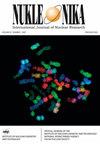一种新的用于分析室内氡活动的地理变异的地质统计学工具
IF 0.3
4区 物理与天体物理
Q4 CHEMISTRY, INORGANIC & NUCLEAR
引用次数: 12
摘要
由于天然放射性,特别是氡(222Rn),人口持续暴露于电离辐射的本底水平。氡气已被列为肺癌的第二大原因,仅次于烟草烟雾。在密闭环境中,氡的浓度会达到有害水平,并受多种因素的影响而发生相应的变化。由于住宅氡的主要来源是地下,因此风险评估和降低不能忽视对当地地质和环境诱发因素的识别。本文提出了一种基于不同空间尺度上的基尼系数计算方法来估算氡浓度的空间相关性和地理变异性。这种变化可以解释为不同地下地质条件的标志。基尼系数计算是一种广泛用于确定不同分布的不均匀程度的统计工具。我们生成了几个模拟的氡分布,并通过比较基于半方差计算的变异函数和基于基尼系数的变异函数来验证所提出的工具。基尼系数变异图可以很好地估计氡浓度的不均匀程度。事实上,它可以更好地限制至少在所研究的变率长度尺度内氡地质源可被视为均匀的临界距离;它还能更好地区分环境因素引起的波动和随机空间不相关噪声引起的波动。本文章由计算机程序翻译,如有差异,请以英文原文为准。
A new geostatistical tool for the analysis of the geographical variability of the indoor radon activity
Abstract The population is continuously exposed to a background level of ionizing radiation due to the natural radioactivity and, in particular, with radon (222Rn). Radon gas has been classified as the second leading cause of lung cancer after tobacco smoke [1]. In the confined environment, radon concentration can reach harmful level and vary accordingly to many factors. Since the primary source of radon in dwellings is the subsurface, the risk assessment and reduction cannot disregard the identification of the local geology and the environmental predisposing factors. In this article, we propose a new methodology, based on the computation of the Gini coefficients at different spatial scales, to estimate the spatial correlation and the geographical variability of radon concentrations. This variability can be interpreted as a signature of the different subsurface geological conditions. The Gini coefficient computation is a statistical tool widely used to determine the degree of inhomogeneity of different kinds of distributions. We generated several simulated radon distributions, and the proposed tool has been validated by comparing the variograms based on the semi-variance computation with those ones based on the Gini coefficient. The Gini coefficient variogram is shown to be a good estimator of the inhomogeneity degree of radon concentration. Indeed, it allows to better constrain the critical distance below which the radon geological source can be considered as uniform at least for the investigated length scales of variability; it also better discriminates the fluctuations due to the environmental predisposing factors from those ones due to the random spatially uncorrelated noise.
求助全文
通过发布文献求助,成功后即可免费获取论文全文。
去求助
来源期刊

Nukleonika
物理-无机化学与核化学
CiteScore
2.00
自引率
0.00%
发文量
5
审稿时长
4-8 weeks
期刊介绍:
"Nukleonika" is an international peer-reviewed, scientific journal publishing original top quality papers on fundamental, experimental, applied and theoretical aspects of nuclear sciences.
The fields of research include:
radiochemistry, radiation measurements, application of radionuclides in various branches of science and technology, chemistry of f-block elements, radiation chemistry, radiation physics, activation analysis, nuclear medicine, radiobiology, radiation safety, nuclear industrial electronics, environmental protection, radioactive wastes, nuclear technologies in material and process engineering, radioisotope diagnostic methods of engineering objects, nuclear physics, nuclear reactors and nuclear power, reactor physics, nuclear safety, fuel cycle, reactor calculations, nuclear chemical engineering, nuclear fusion, plasma physics etc.
 求助内容:
求助内容: 应助结果提醒方式:
应助结果提醒方式:


